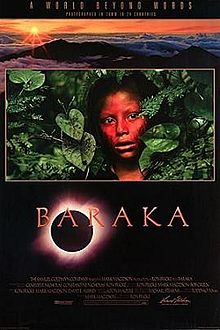 BARAKA is a documentary film with no narrative or voice-over. It explores themes via a kaleidoscopic compilation of natural events, life, human activities and technological phenomena shot in 24 countries on six continents over a 14-month period.
BARAKA is a documentary film with no narrative or voice-over. It explores themes via a kaleidoscopic compilation of natural events, life, human activities and technological phenomena shot in 24 countries on six continents over a 14-month period.
The film is Ron Fricke’s follow-up to Godfrey Reggio’s similar non-verbal documentary film Koyaanisqatsi. Fricke was cinematographer and collaborator on Reggio’s film, and for Baraka he struck out on his own to polish and expand the photographic techniques used on Koyaanisqatsi. Shot in 70mm, it includes a mixture of photographic styles including slow motion and time-lapse. To execute the film’s time-lapse sequences, Fricke had a special camera built that combined time-lapse photography with perfectly controlled movements.
Locations featured include the Church of the Holy Sepulchre in Jerusalem, the Ryoan-Ji temple in Kyoto, Lake Natron in Tanzania, burning oil fields in Kuwait, the smouldering precipice of an active volcano, a busy subway terminal, tribal celebrations of the Masai in Kenya, and chanting monks in the Dip Tse Chok Ling monastery.
The film features a number of long tracking shots through various settings, including Auschwitz and Tuol Sleng, over photos of the people involved, past skulls stacked in a room, to a spread of bones. It suggests a universal cultural perspective: a shot of an elaborate tattoo on a bathing Japanese yakuza precedes a view of tribal paint.
The film consists of twenty chapters divided into three main sections, A1-A3:
A1: Chap. 01-07: Nature untouched by man – indigenous peoples, their rituals as part of nature being integrated.
Chap. 01 – Snow and Ice, Chap. 02 – Temples, Chap. 03 – Light and Shadow, Chap. 04 – The volcano, Chap. 05 – Galápagos Islands, Chap. 06 – Iguazu Falls, Chap. 07 – Africa.
Chap. 08 – Cigarettes, Chap. 09 – Public Bathing, Chap. 10 – Traffic Chaos, Chap. 11 – Mass Production, Chap. 12 – Madness, Chap. 13 – Aircraft boneyard, Chap. 14 – Shadows of the Past, Chap. 15 – Terracotta Army.
A3: Chap. 16-20: Old, still living cultures – The architectural remains of past civilizations – Transience and lasting of all human efforts.
Chap. 16 – Living on the river Ganges, Chap. 17 – Sea of Clouds, Chap. 18 – The Kaaba, Chap. 19 – Starry sky, Chap. 20 – Closing credits.
Source: Wikipedia | Official Website
